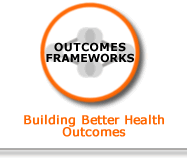
Another way of describing inputs.
Driver Diagrams
A Driver diagram is a three level logic chart. It is a tool to help planning which provides a "theory of change".
Health improvement – a shorthand term for actions taken to address the twin policy goals of improving population health and reducing health inequalities where health includes both the physical and mental dimensions of health and well-being.
Health improvement outcomes – changes in population health and wellbeing status, the individual risk behaviours that are known to cause these and the social, economic and physical environments that shape these health behaviours. These tend to take place in the longer, rather than shorter, term.
Inputs
The financial, human and material resources used to deliver a service or programme
Logic models – A visual way of illustrating the relationships between elements of a programme and the outcomes to be achieved. Logic models therefore help in planning programmes and in defining how to measure the success of the programme.
Outputs
The products, goods and services that are generated by a service or programme to meet the needs of customers
Outcomes
The changes that are likely or achieved as the result of service delivery (or a social intervention) in the short-, medium- and long-term.
Outcomes-focused Performance Management - an approach that extends the focus of management beyond the delivery of planned outputs to include the outcomes (or results) of services for the customers/target population. Funding and accountability are geared to the difference made to the public, or specific population groups In outcome-focused performance management, performance information on results is used in budgeting, planning, management and reporting.
Performance framework – those accountability arrangements set up by organisations/partnerships in order to assess, manage and report actions put in place to achieve improvements.
Performance improvement - A process set up to manage change, address barriers to good performance and achieve improvement in the quality and effectiveness of organisations and services.
Performance information – this can come from a variety of sources including performance indicators, evaluations, customer feedback, service reviews and audits.
Performance indicators – measures of how well a programme or service is being delivered. They may measure inputs, processes, outputs or outcomes but increasingly, public services are being encouraged to focus on outcome-based performance indicators as part of the shift to an outcome-focused approach to performance announced in the Scottish Budget Spending Review in 2007: http://www.scotland.gov.uk/Publications/2007/11/13092240/9.
Performance management – the active use by senior managers of performance information to manage and improve services so that they produce the planned outputs and/or desired results for the customers/target population (often specified in the form of targets)
Performance measurement – the application and use of indicators and measures to assess the performance of delivery organisations; typically, performance measures include the following categories:
Performance reporting - The documentation and reporting of progress in meeting performance targets, including barriers to performance, and the feedback and sharing of such information for learning and improvement purposes.
Process – The activities or work that is done/needs to be carried out to produce specific outputs
Single Outcome Agreements – the performance framework for local authorities and their partners introduced with the Concordat between central and local government in November 2007.
Targets - The desired or expected level and direction of change/improvement for a particular population within a given timescale.

